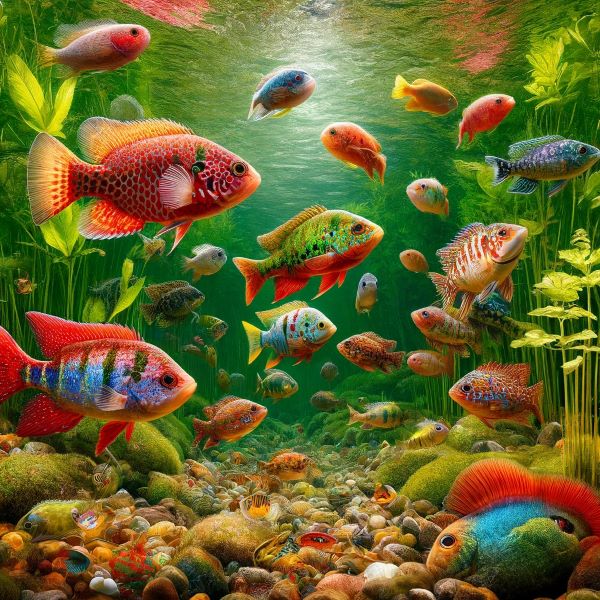Unraveling Nature’s Aquatic Masterpiece

The Lone Star State, renowned for its vast landscapes and diverse ecosystems, harbors a hidden gem beneath its rippling waters: the Texas sunfish. While often overshadowed by more prominent aquatic species, the Texas sunfish quietly thrives in the state’s lakes, rivers, and streams, captivating those fortunate enough to encounter its vibrant presence.
Native to the waterways of Texas, the sunfish species found in this region are as diverse as the state itself, showcasing a kaleidoscope of colors and patterns that mirror the rich tapestry of Texas’ natural heritage. From the striking red hues of the Redbreast Sunfish to the iridescent scales of the Longear Sunfish, each variant possesses its own unique allure, drawing enthusiasts and researchers alike into the mesmerizing world beneath the surface.
Despite its diminutive size, the Texas sunfish holds a significant place in the aquatic ecosystem, serving as both predator and prey in the intricate web of life that sustains the waters of the region. Its role as a keystone species underscores the importance of understanding and preserving its habitat, ensuring the continued health and balance of Texas’ aquatic environments.
In this article, we embark on a journey to uncover the mysteries of the Texas sunfish, delving into its biology, behavior, and ecological significance. From its humble origins to its remarkable adaptations, we explore the fascinating world of this aquatic marvel, shedding light on a creature that epitomizes the beauty and resilience of Texas’ natural landscapes.
Join us as we dive beneath the surface and discover the captivating allure of the Texas sunfish, a testament to the enduring splendor of the Lone Star State’s aquatic realm.
A Diverse Tapestry of Texas Sunfish
In the shimmering waters of Texas, a diverse tapestry of sunfish species paints a vivid portrait of aquatic beauty. From the tranquil depths of pristine lakes to the meandering currents of winding rivers, these charismatic creatures adorn the landscape with their vibrant colors and intricate patterns.
Among the most iconic members of the Texas sunfish family is the Redbreast Sunfish (Lepomis auritus), a striking species distinguished by its fiery red breast and vibrant blue-green hues. Found in abundance throughout the state’s waterways, the Redbreast Sunfish embodies the spirit of resilience, thriving in habitats ranging from slow-moving streams to secluded ponds.
Venture further into the heart of Texas, and you’ll encounter the Longear Sunfish (Lepomis megalotis), a marvel of natural engineering adorned with elongated opercular flaps and intricate mosaics of red, orange, and emerald. With its namesake “long ears” and flamboyant coloration, this sunfish species adds a touch of whimsy to the aquatic landscape, captivating observers with its captivating charm.
In the shallows of Texas’ rivers and creeks, the Bluegill Sunfish (Lepomis macrochirus) reigns supreme, its iridescent scales shimmering like sapphires beneath the sun’s gentle caress. Known for its voracious appetite and tenacious spirit, the Bluegill Sunfish embodies the resilience and adaptability that define life in Texas’ dynamic aquatic ecosystems.
But the allure of Texas sunfish extends beyond these familiar faces, encompassing a diverse array of species each with its own unique traits and characteristics. From the diminutive Redear Sunfish (Lepomis microlophus) to the elusive Warmouth (Lepomis gulosus), every member of the sunfish family contributes to the rich tapestry of life that thrives beneath the surface of Texas’ waters.
Yet, amidst this diversity, a common thread binds these disparate species together: a shared resilience and adaptability that enables them to thrive in the face of environmental challenges. From fluctuating water levels to changing temperatures, Texas sunfish have evolved ingenious strategies to survive and flourish in their ever-changing habitat, showcasing the remarkable resilience of nature’s aquatic masterpieces.
Biology and Behavior of Texas Sunfish
Understanding the biology and behavior of Texas sunfish unveils a fascinating tapestry of adaptation and interaction within the aquatic ecosystem. From their dietary preferences to their reproductive strategies, these sunfish species employ a diverse array of tactics to thrive in the dynamic waters of the Lone Star State.
Dietary Preferences:
| Species | Diet |
| Redbreast Sunfish | Aquatic insects, crustaceans, small fish |
| Longear Sunfish | Insects, snails, small crustaceans |
| Bluegill Sunfish | Insects, crustaceans, small fish, aquatic vegetation |
| Redear Sunfish | Snails, insect larvae, aquatic vegetation |
| Warmouth | Fish, insects, crustaceans, small mollusks |
Reproductive Strategies:
| Species | Reproductive Strategy |
| Redbreast Sunfish | Spawning occurs in shallow nests constructed by males |
| Longear Sunfish | Males construct nests in shallow waters, guard eggs and fry |
| Bluegill Sunfish | Colonial nesters, males build and defend nests |
| Redear Sunfish | Spawning occurs in colonies, nests built in vegetation |
| Warmouth | Spawning occurs in spring and summer, guarded by males |
Territorial Behavior:
- Redbreast Sunfish are known for their aggressive territorial behavior, defending nesting sites against intruders.
- Longear Sunfish establish territories in shallow waters, displaying territorial displays to deter rivals.
- Bluegill Sunfish exhibit colonial nesting behavior, with males fiercely defending territories against intruders.
- Redear Sunfish form loose colonies during the breeding season, with dominant males asserting their authority over nesting sites.
- Warmouth are solitary for much of the year but become territorial during the breeding season, defending nests against intruders.
Feeding Habits:
- Redbreast Sunfish are opportunistic feeders, preying on aquatic insects, crustaceans, and small fish.
- Longear Sunfish primarily feed on insects and small crustaceans, using their elongated opercular flaps to capture prey.
- Bluegill Sunfish have a varied diet, consuming insects, crustaceans, small fish, and aquatic vegetation.
- Redear Sunfish are specialized feeders, using their specialized pharyngeal teeth to crush snails and other hard-shelled prey.
- Warmouth are voracious predators, consuming a wide range of prey including fish, insects, crustaceans, and small mollusks.
Ecological Significance and Conservation Challenges
The ecological significance of Texas sunfish extends far beyond their aesthetic appeal, playing crucial roles in maintaining the health and balance of aquatic ecosystems throughout the Lone Star State. From controlling insect populations to serving as indicators of environmental quality, these charismatic fish contribute to the intricate web of life that sustains Texas’ waterways.
Ecological Roles:
- Prey Base: Texas sunfish serve as an essential prey base for larger predators, including game fish such as bass and catfish, as well as birds such as herons and kingfishers.
- Insect Control: Many sunfish species, such as the Bluegill and Redbreast Sunfish, feed on insect larvae and adults, helping to control populations of pests like mosquitoes and midges.
- Habitat Engineering: Sunfish, through their nesting and feeding behaviors, play a role in shaping and maintaining aquatic habitats, creating microhabitats that benefit a wide range of other species.
- Biodiversity Support: By maintaining healthy populations of sunfish, aquatic ecosystems are better able to support a diverse array of plant and animal life, contributing to overall biodiversity.
Conservation Challenges:
| Challenge | Description |
| Habitat Loss and Degradation | Urbanization, agriculture, and infrastructure development threaten sunfish habitat. |
| Water Pollution | Runoff from agricultural and urban areas introduces pollutants that degrade water quality. |
| Invasive Species | Non-native species compete with sunfish for resources and can disrupt native ecosystems. |
| Overfishing | Unsustainable fishing practices can deplete sunfish populations, threatening their survival. |
Conservation Strategies:
- Habitat Restoration: Efforts to restore and protect critical habitats, such as wetlands and riparian zones, help provide essential breeding and foraging grounds for sunfish populations.
- Water Quality Management: Implementing measures to reduce pollution and improve water quality, such as buffer zones and runoff management practices, helps mitigate the impacts of contamination on sunfish and their habitats.
- Invasive Species Control: Monitoring and control programs targeting invasive species help limit their spread and minimize competition with native sunfish populations.
- Sustainable Fisheries Management: Implementing regulations and sustainable fishing practices, such as catch limits and habitat protection zones, ensures that sunfish populations remain viable for future generations.
The Cultural and Recreational Value of Texas Sunfish
Beyond their ecological significance, Texas sunfish hold a profound cultural and recreational importance, enriching the lives of residents and visitors alike. From centuries-old traditions to modern-day recreational pursuits, these charismatic fish have woven themselves into the fabric of Texas’ cultural heritage, inspiring a deep appreciation for the state’s natural wonders.
Cultural Traditions:
- Angling Heritage: Fishing for sunfish has long been a cherished tradition in Texas, passed down through generations as families gather along the shores of lakes and rivers to cast their lines and share stories of past exploits.
- Indigenous Connections: Indigenous communities throughout Texas have historically relied on sunfish as a vital food source, honoring these fish through traditional ceremonies and cultural practices that celebrate their role in sustaining life.
- Artistic Inspiration: Sunfish have served as muse and motif for artists and artisans across Texas, their vibrant colors and graceful forms immortalized in paintings, sculptures, and other works of art that capture the essence of the state’s natural beauty.
Recreational Pursuits:
| Recreational Activity | Description |
| Fishing | Anglers flock to Texas’ lakes, rivers, and streams in pursuit of prized sunfish species. |
| Birdwatching | Sunfish-rich habitats attract a diverse array of bird species, making them ideal for birdwatching enthusiasts. |
| Nature Photography | The scenic beauty of sunfish habitats provides ample opportunities for photographers to capture stunning images of wildlife and landscapes. |
| Canoeing/Kayaking | Exploring Texas’ waterways by canoe or kayak offers a unique perspective on sunfish habitats and their inhabitants. |
Economic Impact:
- Fishing for sunfish contributes to Texas’ thriving recreational fishing industry, generating revenue for businesses ranging from bait shops and marinas to hotels and restaurants.
- Birdwatching and nature tourism centered around sunfish habitats bolster local economies, attracting visitors who contribute to the purchase of goods and services in surrounding communities.
Educational Opportunities:
- Sunfish provide valuable educational opportunities for students and researchers, serving as subjects for studies on topics such as ecology, conservation, and biodiversity.
- Public outreach programs and interpretive centers offer opportunities for people of all ages to learn about the importance of sunfish and their habitats, fostering a deeper understanding of Texas’ natural heritage.
Collaborative Conservation Efforts for Texas Sunfish
Preserving the rich diversity of Texas sunfish and their habitats requires collaborative efforts involving government agencies, conservation organizations, researchers, and local communities. By pooling resources, expertise, and passion, these stakeholders work together to address the myriad challenges facing sunfish populations and ensure their long-term survival.
Key Stakeholders:
- Government Agencies: Entities such as the Texas Parks and Wildlife Department (TPWD) play a central role in sunfish conservation efforts, implementing regulations, conducting research, and managing habitats to protect native species.
- Conservation Organizations: Non-profit organizations like The Nature Conservancy and local watershed groups work tirelessly to preserve and restore critical sunfish habitats, advocating for policies that prioritize conservation and stewardship.
- Researchers and Academia: Scientists and academic institutions conduct vital research on sunfish biology, behavior, and ecology, providing valuable insights that inform conservation strategies and management decisions.
- Angling and Outdoor Communities: Recreational anglers, birdwatchers, and outdoor enthusiasts contribute to sunfish conservation efforts through citizen science initiatives, habitat restoration projects, and advocacy for sustainable recreational practices.
Collaborative Initiatives:
| Initiative | Description |
| Habitat Restoration Projects | Collaborative efforts to restore degraded sunfish habitats through the planting of native vegetation, erosion control measures, and water quality improvement initiatives. |
| Invasive Species Management Programs | Coordinated strategies to monitor and control invasive species that threaten sunfish populations, including the removal of non-native plants and animals from affected ecosystems. |
| Public Education and Outreach Campaigns | Educational programs and outreach events aimed at raising awareness about the importance of sunfish conservation and fostering a sense of stewardship among local communities. |
| Research Partnerships | Collaborative research projects involving government agencies, academic institutions, and conservation organizations to study sunfish populations, habitat dynamics, and ecological interactions. |
Success Stories:
- Lake Conroe Habitat Restoration: A partnership between TPWD, local conservation groups, and volunteer organizations led to the restoration of critical sunfish habitat along the shores of Lake Conroe, resulting in improved water quality and increased biodiversity.
- Galveston Bay Invasive Species Control: Through coordinated efforts to remove invasive plants and animals from Galveston Bay, stakeholders successfully mitigated the threat posed to native sunfish populations, restoring balance to the ecosystem.
- Citizen Science Monitoring Programs: Citizen Science initiatives, such as the Texas Stream Team, empower volunteers to monitor water quality and habitat conditions in sunfish habitats, providing valuable data for conservation planning and management.
Conclusion: Sustaining the Legacy of Texas Sunfish
As we conclude our exploration of the enigmatic Texas sunfish, we are reminded of the profound significance of these charismatic aquatic creatures and the vital role they play in shaping the ecological, cultural, and recreational landscapes of the Lone Star State. From the tranquil depths of pristine lakes to the meandering currents of winding rivers, Texas sunfish embody the resilience, adaptability, and beauty of the natural world.
Yet, their future remains uncertain, threatened by habitat loss, pollution, invasive species, and unsustainable practices. As stewards of Texas’ natural heritage, it is incumbent upon us to take action to protect and preserve these treasured species and the habitats they call home. Through collaborative conservation efforts, we can ensure that future generations inherit a legacy of thriving sunfish populations and healthy aquatic ecosystems.
Let us heed the call to action, joining together in a shared commitment to safeguarding the rich diversity of Texas sunfish and embracing our responsibility to cherish and protect the natural wonders that enrich our lives. By working collaboratively and harmoniously, we can secure a sustainable future where Texas sunfish continue to inspire awe and wonder for generations to come.




